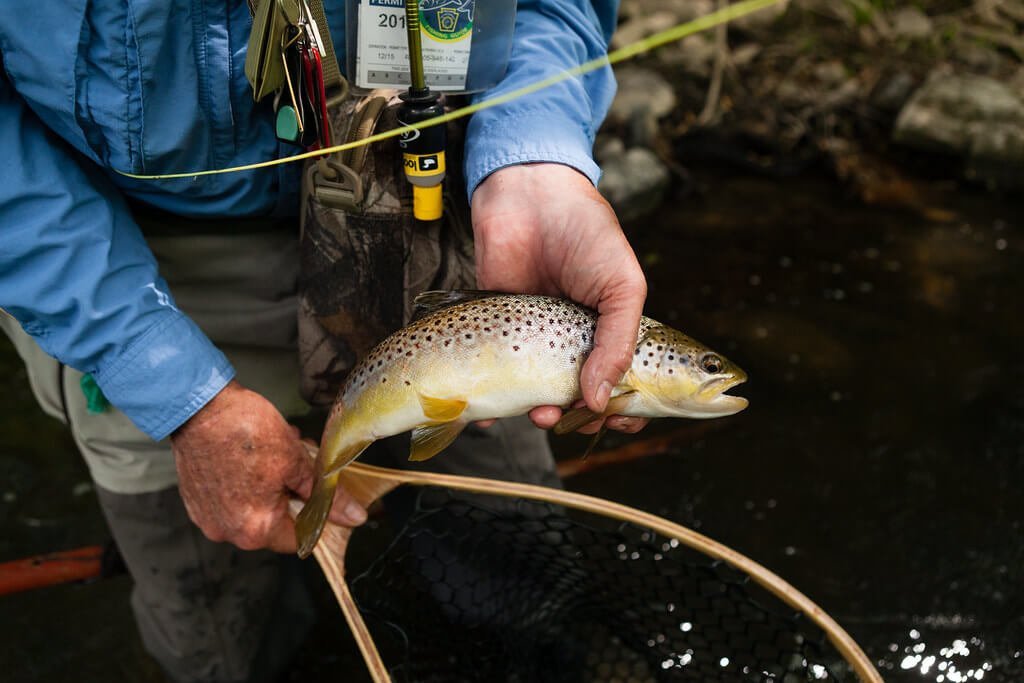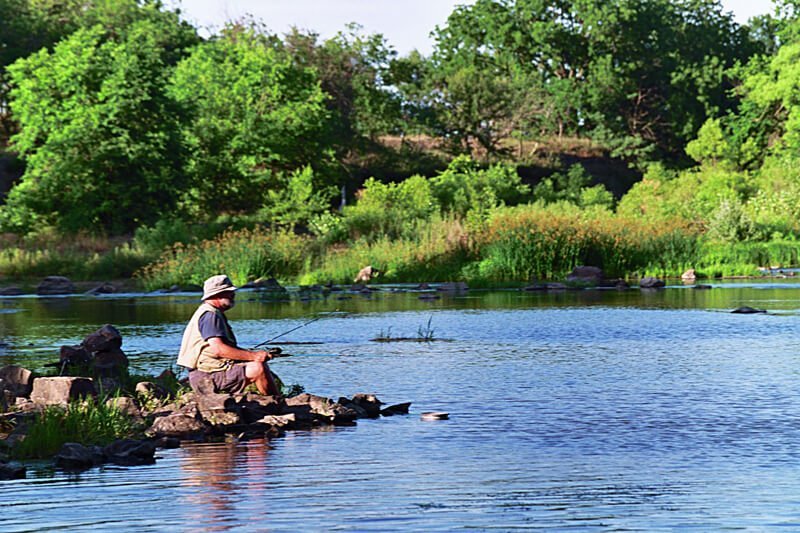8 Best Kansas Trout Fishing Lakes and Streams (2024 Updated)

Kansas is a state in the Midwestern region of the United States. It borders Nebraska to the north, Missouri to the east, Oklahoma to the south, and Colorado to the west. The state offers a trout permit for anglers to fish for trout, and there is a season for trout during the winter months. Webster Reservoir and Lake Shawnee are popular spots for trout fishing in Kansas. Some trout species in Kansas include rainbow trout and brook trout. Most trout tend to feed on insects and other small aquatic creatures. Anglers can try different techniques, such as casting upstream to catch trout in deep holes. Explore some Kansas trout fishing lakes with the right trout fishing tips and gear.
Best Weather for Kansas Trout Fishing in the Year
You can catch trout fish in Kansas year-round. The best time for trout fishing is during the year’s cooler months, from October to May. During this time, the water temperatures are cooler, and the trout are more active.
It’s also important to pay attention to the weather conditions. Rain and overcast skies can make for ideal trout fishing conditions. Additionally, fishing early in the morning or late in the evening when the water is cooler can increase your chances of catching them.
8 Best Kansas Trout Fishing Lakes and Streams
Regarding trout, Kansas may not be the first state that comes to mind for many fishers. However, the Sunflower State has several Kansas lakes and streams that offer great opportunities for catching rainbow and brown trout and brook trout in some cases.
You’re in luck if you’re looking for fishing lakes near me in Kansas. Grab your gear and explore some of the state’s best trout fishing destinations.
1. Lake Charles
Trout fishing is a popular activity in Kansas. Lake Charles is one of the best spots for anglers to fish this species. Anglers can use various techniques, including fly fishing and stream fishing, to fish rainbow and brown trout in the lake. Rainbow is a native trout in this lake.
The Kansas Department of Wildlife, Parks, and Tourism stocks the lake with trout during the trout season, which runs from November 1 to April 15.
To fish them, you should cast them upstream to mimic the natural movement of the fish’s food sources.
Catch-and-release fishing is encouraged to help maintain the trout population in Lake Charles. Anglers should use a treble hook and split shot and carefully handle the fish to avoid injury.
2. Glen Elder Outlet
Glen Elder Outlet is a popular fishing destination in north-central Kansas, USA. The outlet is famous for its diverse fish population. It includes walleye, white bass, channel catfish, crappie, bluegill, brown trout, and rainbow trout.
The Kansas Department of Wildlife, Parks, and Tourism regularly stocks rainbow trout in the outlet during trout season. You can also get brown trout and fish for other species throughout the year, making Glen Elder Outlet a great spot for year-round fishing.
Some good areas to try include the deeper pools and runs in the main channel. Around any underwater structure or cover, such as rocks or logs, may be effective.
Fly fishing with bait and various flies can also be effective for catching them in Glen Elder Outlet. You can use power bait to float above the bottom and slowly release a scent of bait that attracts stocked brown trout.
Live worms can be an excellent option for catching them, especially in moving streams. Spinners are a type of lure that can be effective for trout fishing in moving streams and still waters. You may fish them in deeper water with crankbaits.
If you are fond of crappie fishing, we have this guide to Arizona crappie fishing.
3. Gunn Park East Pond
Gunn Park East Pond is a small urban pond in Fort Scott, Kansas. One of Kansas’s best ponds is stocked with various fish species, including rainbow trout.
From Nov to April, the Kansas Department of Wildlife, Parks, and Tourism stocks the pond with rainbow trout. The pond has a fishing dock and a gravel path around the perimeter from which trout anglers can fish.
You will need a valid Kansas trout permit to fish for trout in Gunn Park East Pond. They can use a variety of baits and lures, including worms, power bait, spinners, and small jigs.
Salmon eggs and dough baits may be effective in the middle of the pond. Areas with deep water, shade, and structure, such as rocks, logs, or weed beds in ponds, are productive for trout.
It’s essential to pay attention to regulations and limits and practice your own often. This will help maintain fish populations for future generations of fishers to enjoy.
4. Kanopolis Seep Stream

Kanopolis Seep Stream is a small, spring-fed stream located near Kanopolis in central Kansas. The Kansas Department of Wildlife, Parks, and Tourism supervises it.
The stream is famous for its cold water and is stocked with rainbow trout during winter, making it a popular destination for trout.
Trout anglers can use various techniques to catch them in the Kanopolis Seep Stream, including fly fishing and spin fishing. Having a valid Kansas fishing license and a trout permit to catch fish trout in this stream is essential.
Fly fishing is a popular method for trout fishing in Kanopolis Seep Stream. Fishers often use small, lightweight flies that mimic the insects found in the stream. Some popular fly patterns for Kanopolis Seep Stream include Griffith’s Gnat, Parachute Adams, and Blue-Winged Olive.
When fly casting in the Kanopolis Seep Stream, it’s essential to approach the stream quietly and cast upstream.
5. Atchison City Lake #1
Atchison City Lake #1 is a 120-acre lake in Atchison County, Kansas. During the winter months, it is stocked with trout. The lake also offers angling opportunities for other species, such as bass, crappie, and catfish. Visitors have access to boat ramps, fishing piers, and restrooms.
Some popular techniques for catching trout in Atchison City Lake #1 include using small spinners, spoons, or jigs with bait like nightcrawlers or power bait and fly casting with nymphs or streamers.
Trout fishers can use light to medium-action rods and reels when using spinning gear. Famous trout anglers’ lures for spinning include small spinners, spoons, and jigs.
Fishermen typically use 4-6 weight fly rods with matching reels and floating fly lines for fly casting. Common fly patterns for trout include woolly buggers, nymphs, and dry flies such as Adams or Elk Hair Caddis.
6. Mined Land Wildlife Area Unit #30
Mined Land Wildlife Area Unit #30, in Southeast Kansas, is a popular destination for trout fishing. The area is stocked with trout in the fall and winter months.
When fishing in Mined Land Wildlife Area Unit #30, it’s important to note that fishing is only allowed during designated times and with the appropriate permit. The Kansas Department of Wildlife, Parks, and Tourism manages the area and sets fishing regulations.
Several spots within the wildlife area are ideal for trout fishing, including the Mined Land Lake.
Other popular areas for trout fishing in Mined Land Wildlife Area Unit #30 include the Upper and Lower Spillways—Turkey Creek, which runs through the area and may be productive. Trout fishers can use various fishing techniques, including fly fishing and spin casting, to catch them in these areas.
7. Pratt Centennial Pond
Pratt Centennial Pond is a small man-made pond located in Pratt, Kansas. It is a popular spot for fishing, particularly for trout. The pond is also home to other fish species, such as bluegill and channel catfish.
One popular area is the fishing dock near the west end of the pond. This area tends to be popular with fishermen. Another good spot is the cove on the north side of the pond. The water tends to be deeper, and the trout are more likely to be found there.
Some fishers prefer to use artificial baits like worms, while others prefer to use lures such as spinners or jigs. Fly fishing is also popular in Pratt Centennial Pond; most fishermen use a variety of flies, such as woolly buggers, nymphs, and midges.
A spinning rod, reel, and rod combo in the 4-6 pound test range suits trout fishing situations. A 5-6 weight fly rod and spinning reel are appropriate for fly casting.
It is important to note that trout fishing in Pratt Centennial Pond requires trout permits. You can purchase it from any vendor with trout permits or a vendor selling hunting and fishing licenses in Kansas.
8. Lake Shawnee

This lake is one of the best Kansas trout fishing lakes. Topeka, Kansas, is a popular destination for fishers seeking to fish trout. The lake is stocked annually with rainbow trout, making it an excellent location for experienced anglers and novice fishermen.
The best spot to cast your leader line is around the holes and the dam area. These areas tend to hold the most trout, where the fish congregate. Additionally, you can try fishing near the inlets or other areas.
To locate trout in Lake Shawnee, it is best to focus on the areas where they may be found, as they may disperse across the lake. Fishing docks, points, and coves are also good spots to look for trout, especially if they are shaded.
Fishing from the bank is possible, and many public access areas exist. Trolling with trout lures, baits, or flies is effective for trout using a small boat or kayak. Due to the high fishing pressure, you should consider different approaches and baits, such as using different colors or sizes.
Catching Trout on the Fly Fishing in Kansas
When fishing for trout in Kansas, it’s essential to understand the local cool streams and the types of flies best suited for the local trout.
Kansas has a few clear water streams and rivers suitable for trout fishing, including the Upper Arkansas River, the Lower Arkansas River, and the Marmaton River.
Dry flies, nymphs, and streamers are effective, but the specific patterns depend on the stream and time of year.
Do I Need a Fishing License while Fishing in Kansas
To fish in Kansas, you’ll need a valid fishing license, whether a resident or a non-resident. Licenses are available for purchase online or through licensed agents, and options include daily or annual passes. Remember that certain water bodies, like designated trout streams, may require an additional trout permit. Always familiarize yourself with Kansas fishing regulations for a fun and legal fishing experience.
You can also read our 10 Best Maine Trout Fishing Lakes and Rivers.
Conclusion
On a final note, fishing trout in Kansas can be a rewarding experience for all skill levels. Most fishermen must obtain a trout permit to fish during the trout season. Webster Reservoir is one of the best trout fishing spots in Kansas. The Kansas Department of Wildlife, Parks, and Tourism issues these permits, which are available year-round.
Fishers can use a range of trout lures, including artificial lures and salmon eggs, to attract trout. Bright colors can also be effective in catching them. Fishers should use slow retrieves when fishing in slow-moving water. Look for deep holes and undercut banks. You can use split shots to help get the fishing line down to the right depth. It is because many of the native trout and species in Kansas are naturally reproducing.

